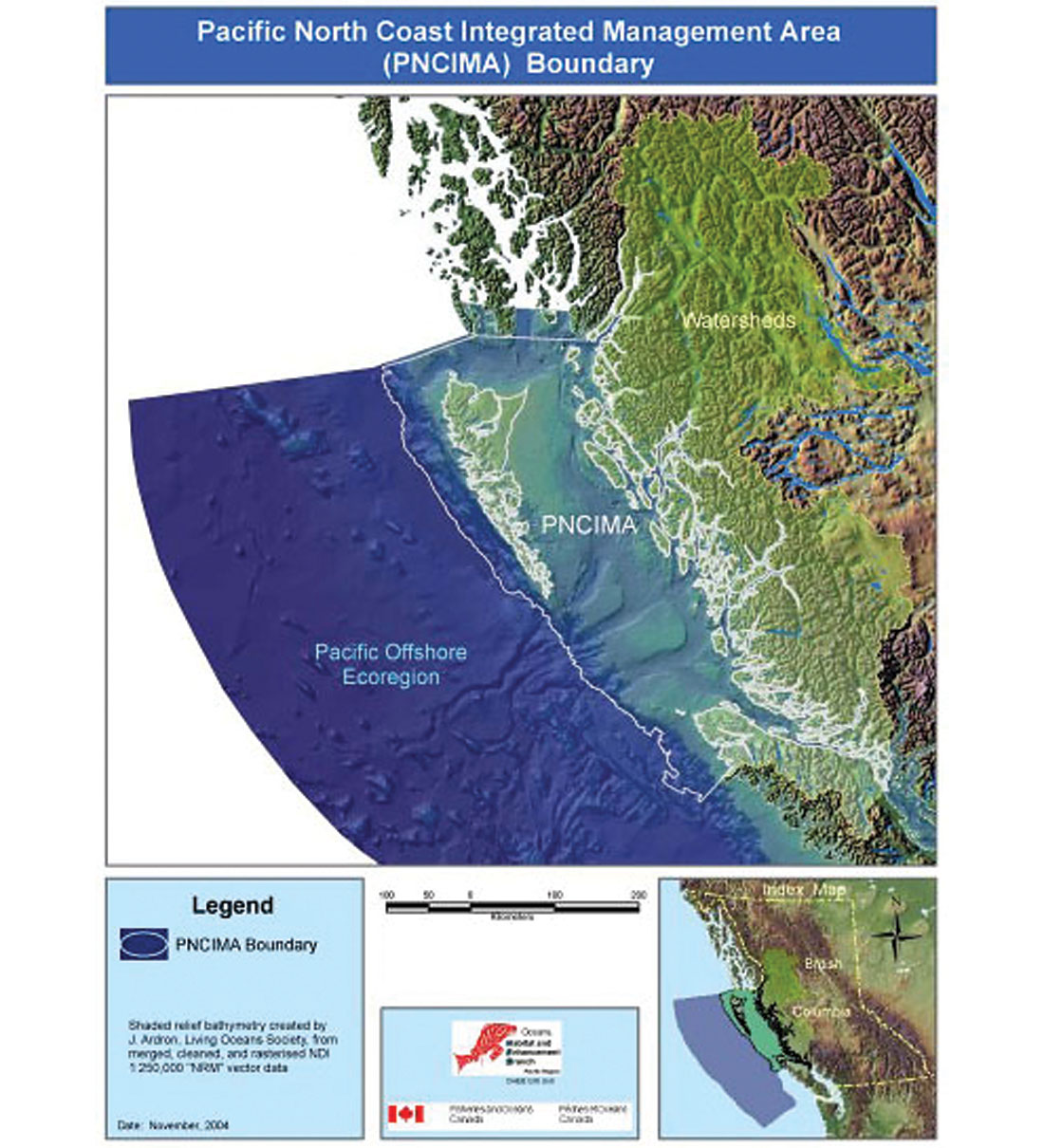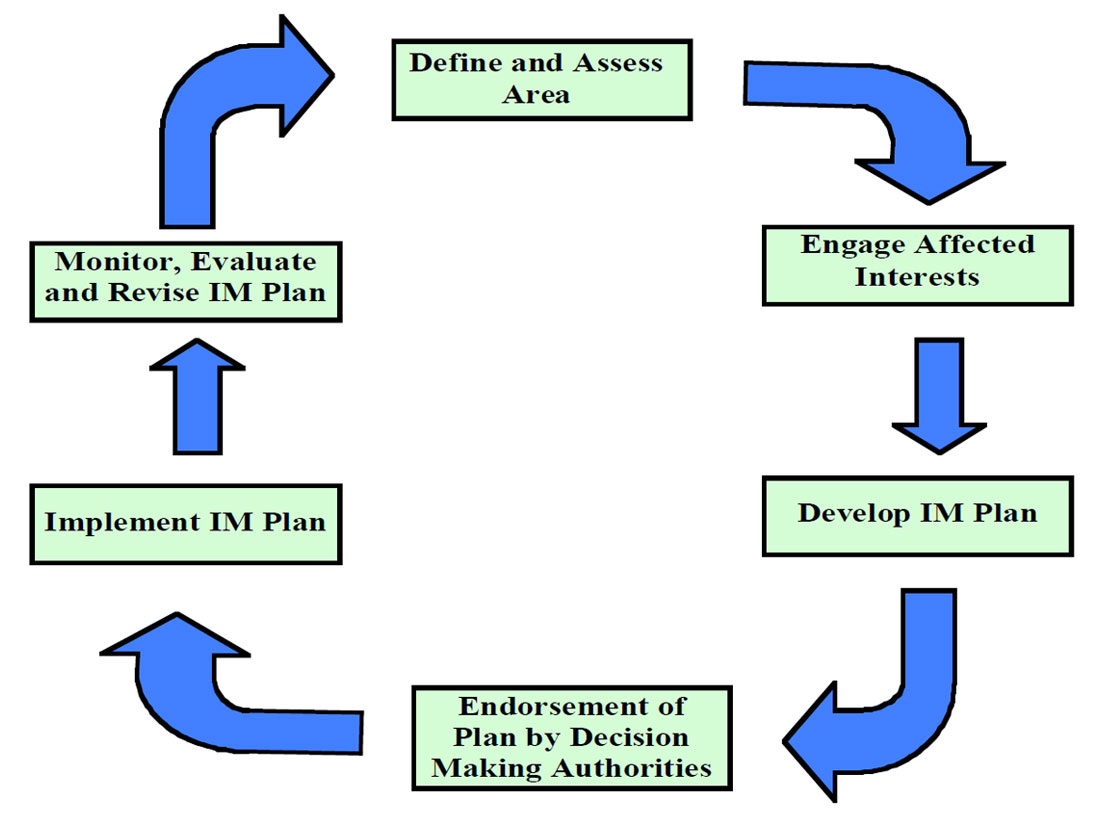The Pacific North Coast Integrated Management Area (PNCIMA) is one of five pilot Integrated Management Planning initiatives being led by the federal Department of Fisheries and Oceans in Canada.1 Based primarily on ecological characteristics including oceanic currents, physiographic considerations, the PNCIMA extends from the Canada-Alaska border in the north to Brooks peninsula, Northwest Vancouver Island and Quadra Island and Bute Inlet in the south.2 The planning area extends seaward to the foot of the continental slope and to the headwaters of coastal watersheds. Although terrestrial and freshwater components are not subject to planning within this initiative, these areas play a critical role in defining ecosystem characteristics and ecological function. Linkages will be forged to compliment and ideally, over the long-term, augment existing and future upland planning and management.
This area is important for food, social and ceremonial fisheries for First Nations, as well as commercial fisheries and recreational fisheries. Aquaculture development is also a key issue in the area, as are tourism, transportation, and potential offshore energy development. A particular feature of the PNCIMA initiative is the proactive involvement of First Nations in coastal and marine resource planning and management.

The overarching goal of PNCIMA is the development of a framework for addressing issues relating to the multiple-use of marine areas, sustainability and conservation. This will be achieved through the development of governance mechanisms, institutional arrangements and a management plan for the area. The intent is to develop an approach that is accepted by stakeholders, endorsed by legislative and regulatory authorities, supported by First Nations and approved by the governments of Canada and British Columbia.
More specifically the PNCIMA initiative has four key objectives:
- To promote ocean management decisions based on shared understanding and appreciation of the ecological, cultural and socio-economic characteristics of the PNCIMA.
- Design an integrated decision making framework for management across sectors.
- Develop institutional arrangements that bring together governments, First Nations, user groups and other interests, resource management, conservation and economic development and enter into agreements on oceans management with specific responsibilities, powers and obligations.
- Contribute to social, cultural, and economic well-being for coastal communities and stakeholders
At the heart of Canada’s vision of Ocean Management is a commitment to citizen engagement in the broadest sense, that is governments at all levels, Aboriginal groups, corporate and sectoral interests, community interests, non-governmental organizations, and Canadians generally. The overall objective is to create governance mechanisms that foster a greater involvement of the people most affected by decisions.

Managing for Sustainability
The Integrated Management approach in the PNCIMA will:
- Identify ocean resources and economic and other opportunities through an ecosystem overview and marine-use analysis.
- Identify the interests and priorities of community, First Nation’s, industry and economic development of the region.
- Assess ecosystems to determine current and emerging threats to ecosystem health and determine a broad system of ecosystem and socio-economic objectives for planning and management responses to those threats;
- Identify the requirements and priorities for monitoring and research in support of the Integrated Management Plan
- Identify priorities and strategies for conservation.
The PNCIMA framework will reduce conflict between different sectors over resource access and use, while providing increased certainty and long-term security for marine-based industries. A set of long-term, overarching ecosystem and human use objectives to support agreed upon outcomes for environmental, economic, social and institutional sustainability will be identified. These high-level objectives will, in turn, be supported by operational objectives. Examples of ecosystem and human use objectives include:
Ecosystem Objectives
- healthy benthic and pelagic communities and species, species at risk and invasive species
- maintain marine ecosystem productivity,
- sustain ocean and coastal habitats, including physical, geochemical and biological components
Human Use Objectives
- community well-being
- economic well-being
- industrial capacity and assets
- integrated management processes
This objectives-based approach will ensure that interrelationships among ecosystem and human use objectives are recognized and reflected in management strategies and actions. The PNCIMA framework will identify common goals, respect the jurisdictional responsibilities of the various levels of government, adapt to issues of regional importance while recognizing the economic, environmental and social values of coastal communities. In this environment, coastal communities will be actively involved in the development, promotion, and implementation of sustainable oceans activities leading to a more viable “on the ground” planning, implementation monitoring and compliance process.











Join the Conversation
Interested in starting, or contributing to a conversation about an article or issue of the RECORDER? Join our CSEG LinkedIn Group.
Share This Article